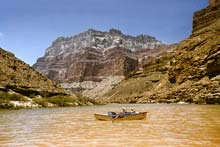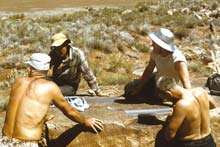
 Custom Search
|
|
| sails |
| plans |
| epoxy |
| rope/line |
| hardware |
| canoe/Kayak |
| sailmaking |
| materials |
| models |
| media |
| tools |
| gear |
| join |
| home |
| indexes |
| classifieds |
| calendar |
| archives |
| about |
| links |
| Join Duckworks Get free newsletter Comment on articles CLICK HERE |
|
|
| CHASING GHOSTS IN THE GRAND CANYON |
| A COLORADO RIVER RUN Thursday, March 22 Up before the sun, at 5:30. Not too many people stirring yet. A few birds chirping, the sky just light enough to see by, the quiet rush of the water flowing past. The plan is for the kitchen crew to be up at 6:30, with coffee call for the rest at 7:00, giving us enough time to pack up our tents and gear before breakfast. The first day of re-packing the boats, Tom Martin tells us, will be slow--we'll be lucky to hit the water by 10 a.m. Thinking of the mountains of gear and the matrix of cam straps required, I mentally adjust Tom's prediction to 10:40 a.m. But then, time doesn't matter too much here anyway. The quiet morning is reminding me that it's been far too long since I've done a long trip in canyon country--and I've never done one in Grand Canyon. A perfect place to be. I can just hear the kitchen crew moving around, heating water, getting ready to serve breakfast. A good time to tell you a bit more about the boats. Moulty Fulmer's Gem Of the five historic boats represented by replicas on this trip, Moulty Fulmer's Gem was the first one built, in 1953. Unlike Norm Nevills's 1940s cataract boats, Gem is based on a McKenzie River dory hull. When Moulty Fulmer first saw a McKenzie river boat, he knew it was something that could handle the big water of Grand Canyon. Strong rocker for maneuverability in fast water, flared sides for stability and buoyancy, it almost seemed meant for the rapids of the Colorado--and with the addition of decks fore and aft, and big buoyancy chambers bow and stern, Fulmer had his boat. Built in 1953 out of plywood, Gem was launched in 1954, and went on to run Grand Canyon for years, the first dory design on the Colorado. If you run into a hard boat on the Colorado today, its pedigree starts here, with Moulty Fulmer's Gem.
The replica Gem on our trip was built by Tom Martin. In the process, Tom discovered the reason for Gem's tiny transom (a true McKenzie River dory is a double ender):Gem's hull is so short and fat that Moulty Fulmer wasn't able to bend the plywood hull panels in far enough to make the double-ender Fulmer had hoped for. Still, with its banana-like rocker, both ends of the boat are out of the water anyway, and nothing was lost with the addition of a transom. Badger Creek Rapid Badger Creek Rapid, like most of the rapids we'll run, is the result of debris flushed into the Colorado River from an intersecting side canyon--two of them, actually. Look at Badger Creek Rapid from above and you'll see the shape of a cross, with the main Colorado running generally southward between tall cliffs, and two tributaries (Jackson Creek on river left, and Canyon Creek on River right) crossing at the same point. The boulders and debris washed down these tributary creeks chokes off the Colorado, forcing it to splash and surge its way over the obstacles. Those constrictions create the standing waves, whirlpools, eddies, holes, and drops that we'll have to find a way through. Right-side up, with luck. Besides giving us our first real chance to film the replica boats in action, today will be my first test at the oars of my raft. Badger Creek, at river mile 8 (our launch point at Lee's Ferry was mile 0), is the first real rapid we'll face. It's a 15' drop in about 1/6 of a mile, and is rated 5 out of 10 for difficulty. We'll see... Finally, don't be misled by the detail I'm providing here about the rapid. If it sounds like I know what I'm talking about, that's because I've stolen the information from the fourth edition of RiverMaps' Guide to the Colorado River in the Grand Canyon--a collection of topographic maps that covers the river from Lee's Ferry to South Cove. Tom Martin (with co-author Duwain Whitis) wrote it. So the information is his; the mistakes (I'm sure there will be some) are mine. Now I'm off to pack up my tent and gear, and maybe have enough time left over to explore a ways up Seven Mile Draw (which empties into the river here at Six Mile Camp, at river mile 6-- go figure) before we launch. The Day's Run Badger Creek Rapid, it turns out, is fairly idiot-proof. Line yourself up at the center as you begin and the river takes you where you want to be--which is definitely not always the case. Still, the veteran river runners on the trip agree that Grand Canyon whitewater tends to be like that. The trick is knowing where to start each run. After the rapid we stop for lunch, and to re-match a photo from the 1957 trip. Here Moulty Fulmer, Brick Mortenson, Pat Reilly, and Dwayne Norton stopped to discuss their strategy for the high water. Dave Mortenson has a photo of the four men gathered around a boulder, considering their strategy for the extremely high water they were facing that year. Dave calls for volunteers to re-stage the photo, and thanks to my floppy hat I get to play Pat Reilly. A few minutes of adjusting poses ("sit taller." "can you straighten your arm?"), a few photos, and the rematch is done.
The rest of the day is flat water and small ripples we don't bother to scout. The flat water is deceiving, though, because "downstream," it turns out, is largely a myth. The river goes where it wants to go, and unless you have an eye for the right line, you'll find yourself rowing upstream as the water swirls and eddies. There are subtle clues that let the trips good rowers keep moving fast just by positioning their boats in the right place. It's a knack I'm determined to pick up for myself. I don't have it yet. I've been rowing harder than the good boatmen, with less to show for it. We're behind schedule by afternoon, and stop to discuss whether we'll end the day by running House Rock Rapid today as originally planned. Boat after boat, though, comes in ready to camp here, above the rapid. It's been a long day for everyone: filming Badger Creek Rapid, re-matching photos, and for us beginners, learning to read the river so we can keep up on the flat water. We're all happy to camp. After finishing the dinner dishes (it's my team's duty night), I'm headed for bed at 9 p.m. Tomorrow we'll start with House Rock Rapid.
*** |




